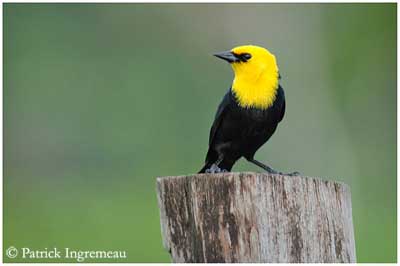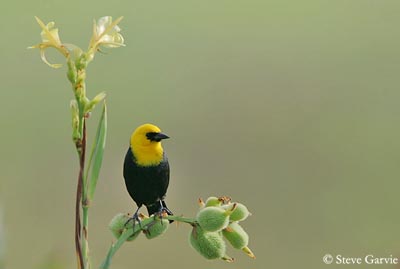
Yellow-hooded Blackbird
Agelaius icterocephalus
Passeriforme Order – Icteridae Family
BIOMETRICS:
Length: 16-18 cm
DESCRIPTION:
Yellow-hooded Blackbird is a beautiful black and yellow blackbird often seen in wetlands.
PROTECTION / THREATS / STATUS:
Yellow-hooded Blackbird is locally common and its populations are not globally threatened at this moment.
Fr: Carouge à capuchon
All : Gelbkopfstärling
Esp : Turpial de Agua
Ital : Ittero dal cappuccio giallo
Nd : Geelkaptroepiaal
Photographers:
Steve Garvie
RAINBIRDER Photo galleries
Patrick Ingremeau
TAMANDUA
Marc Chrétien
MURINUS
Text by Nicole Bouglouan
Sources :
NEW WORLD BLACKBIRDS – THE ICTERIDS by Alvaro Jaramillo and Peter Burke – Helm - ISBN : 0713643331
PORTRAITS D’OISEAUX GUYANAIS - Groupe d'étude et de protection des oiseaux en Guyane (GEPOG) - Ibis rouge éditions - ISBN: 2844501842
A GUIDE TO THE BIRDS OF COLOMBIA by Steven L. Hilty and William L. Brown - Princeton University Press – ISBN 069108372X
Arthur Grosset's Birds (Arthur Grosset)
Discovering the birds of Trinidad and Tobago (Brian Ramsey)
Birds in Suriname, South America (Jan Hein Ribot)

Yellow-hooded Blackbird adult male in breeding period has black body plumage slightly glossy blue-green, except the bright yellow hood extending from the head to the upper breast and including the nape. Lores and subloral area (below the lores) are black.
Strong, conical bill is black. Eyes are dark brown. Legs and feet are black.
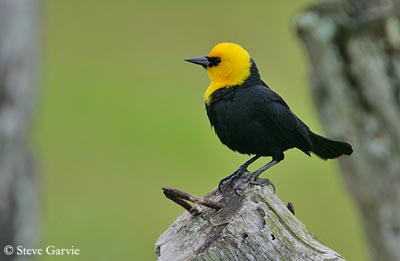
Male in non-breeding plumage is very similar, but we can see some yellow tips to the black feathers of breast and back. The yellow hood may appear slightly olive-yellow on crown and nape. Tertials show some buff tips.
Adult female is duller with olive-brown body plumage, slightly streaked darker brown. Rump is dark olive. Wings and tail are blackish-brown. Underparts are olive-green slightly streaked darker.
She has dull yellowish hood, but she lacks the strong contrast of colours visible in male. Head is rather greenish-yellow with paler supercilium. Chin and throat are brighter yellow but with green tone. Pointed bill is blackish, with paler lower base. Eyes are brown. Legs and feet are blackish.
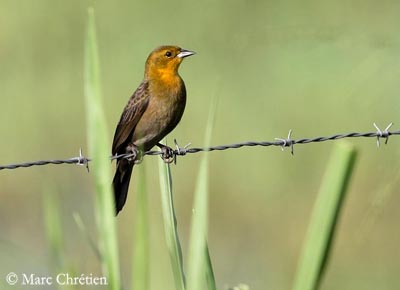
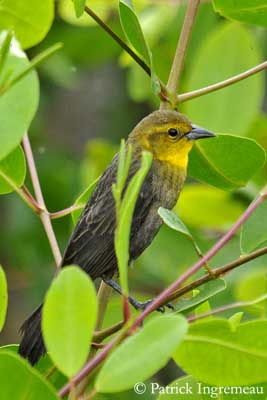
Juvenile is similar to female with duller plumage. It has brighter yellow on throat.
Young male is larger than young female, and shows black feathers on belly and vent, and blackish wings.
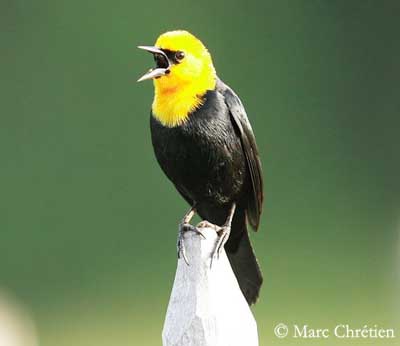
VOICE:
Yellow-hooded Blackbird is a very nice bird which utters unmusical song! Song is laboured, with faint first note, and second mostly loud and rasping, such as “took – TOOWEEEZ”, sometimes followed by musical down and up “te-tidle-de-de-do-dee”.
Yellow-hooded Blackbird common call is a sharp “chek” or “chip”. We can also hear a descending whistle.
HABITAT:
Yellow-hooded Blackbird lives and nests in swampy areas. It is common in freshwater marshes, rice fields and flooded wetlands. They need emergent aquatic vegetation for nesting. This species is largely sedentary in its range. Some populations can perform seasonal movements, according to the dry or wet season, giving them the flooded and wet areas they need.
RANGE:
Yellow-hooded Blackbird lives in northern South America, Brazil, Colombia and Venezuela, the Guianas, along the sides of the Amazon River and to Peru. It is also found in Trinidad and Tobago.
BEHAVIOUR:
Yellow-hooded Blackbird is gregarious all year round and usually seen in small groups. During breeding season, they feed in cultivated areas close to the marshes where they nest. Outside breeding season, they forage in pastures and cultivated areas. However, they roost in marshes all year round.
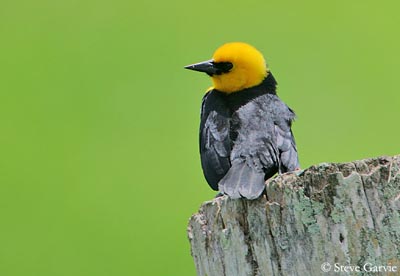
Yellow-hooded Blackbird performs spectacular and typical behaviour when breeding season starts. Adult males gather in colonies of up to 30 birds in marshes, and they start to build the nest. In this species, nest plays an important role in male displays. In order to attract females to these nests, males sing and display at nest-site.
Male Yellow-hooded Blackbird may mate with several females, up to five. When a female comes to the nest, male remains with her, but as soon as incubation is started by female, it leaves her and begins the construction of a second nest, and tries to attract a new female. Each female incubates in a nest built by the male.
In order to attract a female, the male performs displays at nest-site. When female approaches, male flies to her with fluttering flight. During this flight, the male falls down into the grasses or reeds, with stiff wings and while singing. It can do it several times. If female is receptive, she follows it to the nest. Then, she remains in the vicinity of the nest and lays the first egg two to five days later. If male builds the nest, female makes the lining just before the laying.
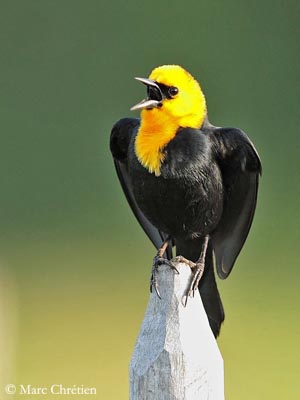
Male may performs some territorial and aggressive displays against rivals, showing the displaying male perched on a stalk or a reed, with fluffed feathers and fanned tail, while it is singing.
In more intense displays, male raises and flutters its wings. Some males can have an isolated territory in lower quality habitat, and in this case, they defend their area.
FLIGHT:
Yellow-hooded Blackbird performs beautiful flight displays, with fluttering wings.
REPRODUCTION:
Breeding season varies according to the region. Yellow-hooded Blackbird needs marshes with emergent vegetation. Breeding period depends on this vegetation.
Male builds the cup-shaped nest with aquatic plants. This nest is anchored to several stalks or reeds of the marsh vegetation, at about 50 cm above water.
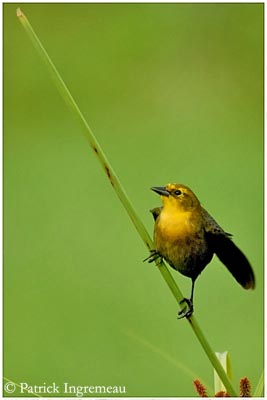
Female usually lays 2 or 3 pale blue eggs with dark markings. Incubation lasts about 10 to 11 days, by female. Young fledge at about 11 days of age.
Male can help for feeding the young, but female does most of the work.
Nests often suffer predation and numerous young die by starvation.
Yellow-hooded Blackbird is a common host of the Shiny Cowbird. Female leaves the nest if there are more of three cowbird eggs in her nest. Within a colony, if parasitism is too much high, the entire colony abandons nests and eggs.
But some females can identify cowbirds eggs and remove them within 24 hours. In other case, female covers cowbird eggs with new lining.
Males are very aggressive towards female cowbirds, and chase them away from the nests. Other males of the same colony can chase the intruder if the owner is feeding elsewhere.
Finally, few young cowbirds fledge from blackbirds’ nests.
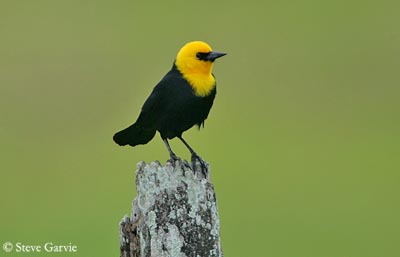
DIET:
Yellow-hooded Blackbird feeds mainly on insects and gives this kind of food to its nestlings.
It feeds in marshes, pastures, cultivated areas and rice fields.
